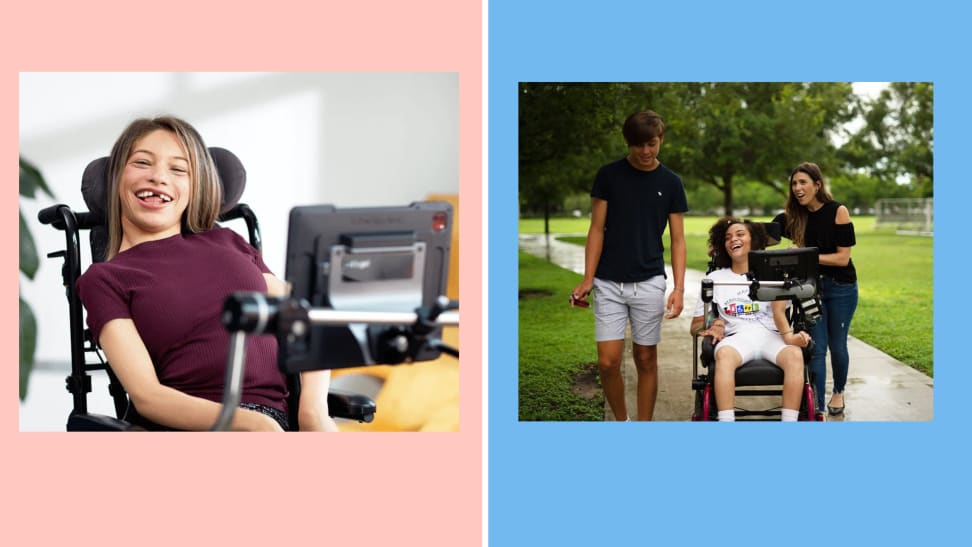My-own-voice gives natural voices to those with ALS, CP
Giving speech to a silent minority
 Credit:
Reviewed / Tobii Dynavox
Credit:
Reviewed / Tobii Dynavox
Products are chosen independently by our editors. Purchases made through our links may earn us a commission.
Tobii Dynavox is a world leader in Augmentative and Alternative Communication (AAC) devices, and the company is currently showing its latest and greatest tech at CES 2023. Following its acquisition of a speech-focused outfit called Acapela Group earlier this year, the new partnership aims to further a joint mission to bring speech to those facing difficulty with expression. In particular, persons with ALS, cerebral palsy, and spinal cord injury have a lot to gain from the the new developments.
Now that Acapela Group has become an independent subsidiary of Tobii Dynavox, its AAC devices can become far more personal by offering opportunities for persons with disabilities to speak with a synthetic voice similar to the one they may have lost through disease progression.
Leveraging as little as 50 sentences recorded on any device with an average microphone, Acapela Group’s My-own-voice technology can create a facsimile digital vocalization in just a few hours. “It's mainly based on artificial intelligence,” Acapela Group CEO Remy Cadic tells Reviewed.
“What we do, [is] we train a large neural network, thanks to all our audio material that we have already recorded in studio for many, many years. And, based on the 50 sentences, we manage to extract the path of the identity of the voice, and then transfer it to the bigger neural network so that the neural network is taking the footprint of the voice, and taking the identity of the voice, so the person can then communicate with a synthetic voice with the same vocal identity as the recordings.”

My-Own-voice samples can be recorded on any device with a decent microphone.
The company’s “voice banking” technology currently supports nearly 20 different languages and has more than 3,000 users worldwide. By 2024, Acapela hopes that number will swell to support a customer base of 10,000 participants.
AT CES 2023, Acapela’s showpiece is version 4 of its My-own-voice software. According to its makers, the update features a massive step forward in overall quality thanks to use of artificial intelligence and bespoke algorithms tailored to grabbing the best data from the 50 samples.
Cadic describes the development as a breakthrough over Acapela’s earliest iterations of the technology. “When we started, five years ago, the patient had to record for eight hours. It was a really, really long process. And then the quality I have to say, at that time, was not really good. From time to time, we had to say 'you've recorded eight hours, but result is not really satisfactory.'”
Those shortcomings don’t happen much with the latest build, though Cadic still believes users should record their voice samples as soon as possible to achieve the best outcome.
Such high quality does have a cost, though in some cases prices may be subsidized by insurance and medical partners. In its current state, My-own-voice is $999 for a perpetual lifetime license or $99 annually. Users can run through the test for free to decide if they like the results, then the voice can be downloaded for use on a Tobii Dynavox device, mobile phone, or any other AAC product.

My-own-voice was honored with an Innovation Award at CES 2023.
From Cadic’s point of view, he’d rather push for top-tier innovation over rushing to lower prices. “Our focus at that company has always, and will remain, to deliver quality to our customers,” he says, “so we usually don't try to fight on the price.
“We want to deliver quality to our customers, so we really try to maintain the same price and improve the quality over time. This has been our strategy in the last years. I have to say, we might even be, at some point, in a position to increase our pricing, because we have to finance our investment, our R&D. And we are delivering higher quality, we are delivering more flexibility over time, and that requires investment.”
Through curated voice samples offered by the company, this emphasis on quality is evident. Despite being slightly robotic in delivery, the actual tone and timbre of Acapela’s synthetic voices appeared to be a nearly a perfect match for the original recordings whether the speaker was a child or an adult. While we’ve yet to test the platform ourselves, the results we did experience were a marvel to hear.
The ability to communicate is essential for any human to thrive, and events like CES offer amazing opportunities to show how technology can be used to enhance those fundamental functions in life-changing ways. Nothing can ever quite compare to being able to speak through a natural process, but technologies like the ones Acapela Group offers give individuals feeling shunned by society the chance to speak in a way that sounds as familiar and special as the family members, friends, and loved ones we know them to be. Learn more about Acapela Group


